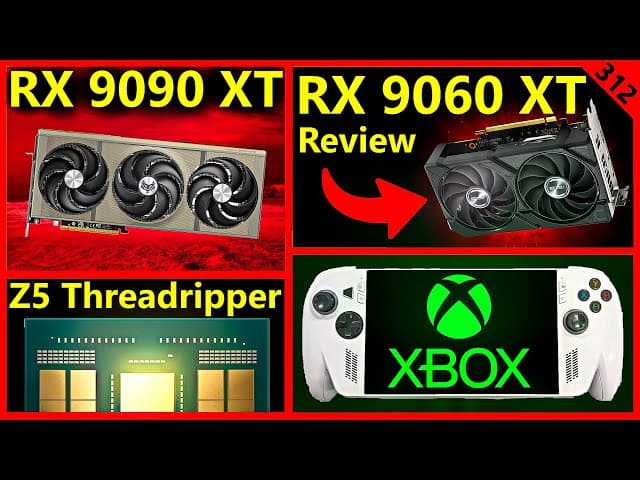
I’ll be honest-the first time I saw the rumors swirling about a Radeon RX 9090 XT, my gut reaction was, “Wait, didn’t AMD just launch a flagship? Why throw a ‘supercharged’ version into the ring now?” But AMD’s a company that loves wringing every last bit of performance out of its silicon. If this die-shrunk Navi 48 with GDDR7 is real, they might not just be rehashing the last-gen-this could be their big swing at NVIDIA’s ultra high-end. Or, it could be yet another paper launch aimed at luring “spec chasers” while real gamers keep using what they’ve got until prices make sense. I had to dig in.
This rumor dump mostly focuses on the die shrink and GDDR7 jump. The move to a smaller node (what, TSMC N4 or something even more exotic?) should mean higher clocks and better power efficiency. GDDR7 is a legit leap—if those numbers are real, you get way more bandwidth, which will matter at high resolutions and AI-accelerated compute… but for most gaming loads, 32GB of VRAM is pure flex unless you’re doing workstation-level stuff. The part that sticks out? Not a new architecture, just overclocked, re-fabricated Navi 48—and that’s either economic genius or squeezing blood from a stone, depending on actual results.
The moment the rumors mentioned “a bit like Radeon VII”—and not a true next-gen RDNA—I instantly flashed back to AMD’s 2019 HBM2 beast. That card was bizarre for gamers: tons of VRAM, lots of bandwidth, but rarely felt faster except in edge-case workloads. Here, AMD’s allegedly packing 32GB of GDDR7 and boasting “40% more speed,” but without fundamentally changing the underlying shader count. So, is this a clever use of more mature manufacturing and fast memory, or just marketing smoke?
The highlight—if true—is clock speed. A smaller, more efficient node lets you push way higher frequencies without needing a nuclear reactor to power your tower. And GDDR7? That’s genuinely exciting if you run at ultra-high resolutions or juggle enormous textures/modding datasets. I love the idea of finally getting memory that isn’t the bottleneck—if it doesn’t destroy latency.

Look, die shrinks have rescued plenty of “meh” GPUs in the past, but they’re rarely market shakers. This rumored 9090 XT sounds less like the birth of RDNA 5 and more like AMD learning from the Radeon VII: take the existing top dog (9070 XT), re-spin it on a tighter node, and throw in enough VRAM to make even workstation-class cards uncomfortable. But does this compete with NVIDIA’s 4090, or just nibble around the margins?
Right now, NVIDIA’s got the brute force advantage—especially in productivity and AI tasks, thanks to CUDA. And even in pure rasterized gaming, the 4090’s raw core count isn’t matched here (unless something drastic changes beyond these rumors). Sure, clock speeds and bandwidth matter—especially at 1080p where bottlenecks get weird—but fundamentally, AMD’s just making a faster, thirstier version of the 9070 XT. That can work for a halo product, unless it becomes Radeon VII 2.0 (great numbers, awkward pricing, niche use).
My main hope is that AMD leverages this as a price disruptor instead of a niche halo card. If this thing drops at $1,000 and gets anywhere close to the 4090 in regular gaming, suddenly NVIDIA’s monopoly gets some much-needed pressure. But if it’s just more expensive than the 9070 XT with zero new features, it’s going to get the same cold shoulder as Radeon VII did after launch.
I can blab all day about specs, but who’s this even for? If you’re running triple-4K displays for creative work, compiling huge AI datasets, or modding Skyrim like it’s a full-time job, the extra VRAM and bandwidth will sing. But for 95% of gamers, a 9070 XT (or even a good last-gen NVIDIA card) already crushes newly released games at 1440p and 4K with less headache (and likely lower street pricing).
Three practical headaches stuck out to me:
If this rumor holds, I’d watch it for four kinds of users:
If you’re just looking to max out AAA games at 1440p with ray tracing on, this probably isn’t your card. Neither is it the best pick if you value software polish, day-one driver support, or rock-solid feature sets—NVIDIA still wins here, and it’s not close. The 9090 XT is, at best, a tool for power users who know exactly what they’re buying.
It took me a while to remember why rumors like the 9090 XT always tug at my inner hardware nerd: it’s the thrill of seeing AMD push silicon to the absolute edge, just to see how far they can go with one last architectural dance before the next gen hits. I can’t help but root for a $1,000 card that genuinely shakes up the status quo—even if the engineering “innovation” is more about clever repackaging than new foundations.
The catch, as always, is in the details. If this is Radeon VII 2: Electric Boogaloo—impressive specs, niche appeal, rough launch pricing—it’ll fade fast. But if AMD genuinely manages near-4090 gaming performance for a grand, the market finally gets some heat. My verdict? Fun to watch, but I’d keep my wallet closed until we see real benchmarks and street pricing. Early adopters, keep your options open.
A potentially clever, maybe pointless exercise in die-shrunk speed—with niche appeal for creators, but only worth it if street prices stay sane.
Get access to exclusive strategies, hidden tips, and pro-level insights that we don't share publicly.
Ultimate Tech Strategy Guide + Weekly Pro Tips